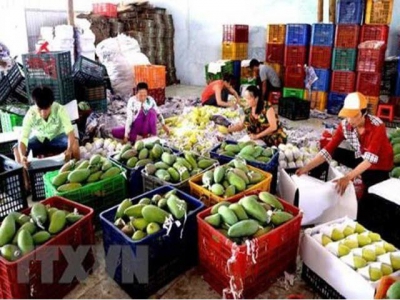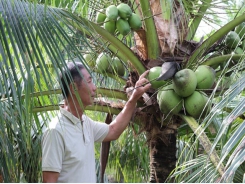China tightens regulations on farm imports

HANOI - Vietnamese farm products exported to China are expected to face difficulties given the growing volatility around the world and region, the trade disputes and tightened regulations, the Ministry of Industry and Trade (MOIT) told a workshop on September 13.
Mangoes are packaged for export. Vietnamese agriculture products exported to China are expected to face difficulties - PHOTO: VNA
China is Vietnam's leading agricultural consumer market. According to enterprises in the sector, the Chinese market offers high consumption and low transportation costs.
However, throughout 2019, exports of agricultural and aquatic products to China have lost steam as the country has tightened regulations on product origin and food safety.
The export growth of agricultural products to China in the 2016-2018 period reached 12.5%, though it decreased by 7.2% in the first eight months of this year, experts told attendees at the workshop titled “Boosting agricultural exports to China,” co-organized by MOIT and the Ministry of Agriculture and Rural Development.
Constrained domestic demand resulting from the trade dispute between the United States and China and the devaluation of the Chinese currency are some of the main factors contributing to the downturn in agricultural exports to Vietnam’s northern neighbor.
China’s stricter requirements on packaging and origin traceability for agricultural imports, which took effect recently, have added to the challenging situation.
“Vietnam has signed quite a large number of free trade agreements (FTAs), which open up potential markets for agricultural and aquaculture goods,” said Tran Thanh Hai, deputy director of the Import and Export Department.
Tariff is just one part of the negotiation of an FTA; animal and plant quarantine is another tough issue for countries opening up their agricultural markets.
In the context of increased technical barriers in terms of standards and rules on quarantine, food safety and hygiene not only in China but across the world, the Ministry of Industry and Trade said, agricultural production must be restructured to provide high-quality, value-added products.
Last year, China spent US$2.7 billion importing vegetables and fruits from Vietnam, mainly dragon fruit, mangoes, durians, watermelon, pineapple, litchis, longans and sweet potato. More than 60% of Vietnam’s agricultural products are shipped to China through informal channels, said Wen Xi Chen, economic counselor at the Chinese Consulate General in HCMC.
The northern neighbor has allowed the formal import of only eight kinds of fruit from Vietnam: watermelon, dragon fruit, litchi, banana, longan, jackfruit, mangoes and rambutan.
Có thể bạn quan tâm
Phần mềm

Phối trộn thức ăn chăn nuôi

Pha dung dịch thủy canh

Định mức cho tôm ăn

Phối trộn phân bón NPK

Xác định tỷ lệ tôm sống

Chuyển đổi đơn vị phân bón

Xác định công suất sục khí

Chuyển đổi đơn vị tôm

Tính diện tích nhà kính

Tính thể tích ao hồ




 Vietnamese produce struggle to enter China
Vietnamese produce struggle to enter China  Bến Tre develops value chains for key agricultural…
Bến Tre develops value chains for key agricultural…